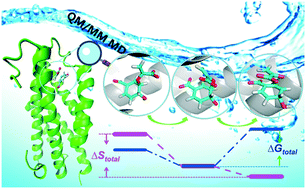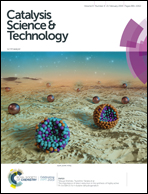Understanding the entropic effect in chorismate mutase reaction catalyzed by isochorismate-pyruvate lyase from Pseudomonas aeruginosa (PchB)†
Abstract
Elucidation of the role of entropy in enzymatic reactions can be utilized in the de novo design of enzymes or protein engineering. Recently, the change in entropy in the enzyme-catalyzed chorismate mutase reaction brought about uncertainty as a result of an experiment using PchB, in which the measured change in entropy was comparable to the reported value for the uncatalyzed reaction in an aqueous solution, which contrasted with the general proposed entropy-driven mechanism. On the basis of a sufficient sample from quantum mechanics/molecular mechanics molecular dynamics simulations, the entropic effect in the PchB-catalyzed chorismate mutase reaction has been determined for the first time. Calculations suggest that the PchB-catalyzed chorismate mutase reaction is entropy-driven. An additional entropic penalty was revealed from the substrate preorganization process, which led to a remarkable apparent entropic effect in the reaction. Our findings provide an explanation of the uncertainty regarding the large measured entropic effect in experiments and confirm the entropy-driven character of the PchB-catalyzed chorismate mutase reaction. The clarification of the change in entropy in this enzymatic reaction would provide useful clues for future enzyme design projects.



 Please wait while we load your content...
Please wait while we load your content...